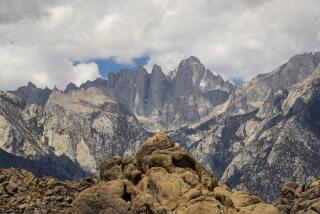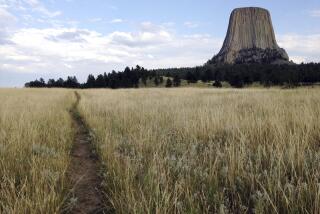Climber Dean Potter, friend tried to clear ‘notch’ at Yosemite before deaths
- Share via
Rock climbers Dean Potter and Graham Hunt, who died in a BASE-jumping accident at Yosemite National Park on Saturday, were attempting to clear a “notch” on the mountain but slammed into the rock instead, an official said Monday.
Mike Gauthier, chief of staff for Yosemite, described a notch as a steep and rocky ridgeline that is “spiny like a stegosaurus.”
Related: For Dean Potter, BASE jumping was spirituality, not sport
Potter had jumped from the same point at least 20 times, and Hunt may have too, Gauthier said.
Potter and Hunt jumped around nightfall from Taft Point, an overlook about 3,000 feet above Yosemite Valley, said park spokesman Scott Gediman. They were wearing wingsuits, Gauthier said.
Gauthier said he was told that neither of their parachutes deployed. The pair’s spotter, a woman, was at Taft Point during the jump but has asked not to be named.
The spotter photographed the jump, which Gauthier said occurred around 7:30 p.m. Gauthier said the spotter heard what she thought sounded like parachutes opening or an impact sound. She couldn’t see them crash, and called out to them.
Related: Dean Potter knew dangers of extreme climbing
She tried to contact them via text as they had planned, but there was no response.
Around 9 p.m., she informed park officials of their disappearance.
A search-and-rescue operation was launched early Sunday morning, with up to 100 people including park rangers and volunteers surveying the park for the men, Gediman said. Crews in a California Highway Patrol helicopter spotted their bodies on the wall of rock along Yosemite Valley, and both were flown out, Gediman said.
Potter and Hunt jumped separately but at about the same time, Gediman said, and their bodies were found on a rock outcropping below Taft Point. Gediman would not speculate on what went wrong, saying the cause of their deadly fall was still under investigation.
“Base jumping in and of itself is a high-risk activity. You’re jumping off a cliff with a parachute.”
Below Taft Point, there’s are rock outcroppings and slabs of granite. Generally, when people jump, their goal is to land in Yosemite Valley.
There were witnesses to the men’s jumps, and they are being interviewed by investigators, he said.
Both were well known within the tightknit climbing community that has proliferated around Yosemite, and their deaths struck a blow.
“I can’t emphasize enough how tragic this is,” Gediman said. “Dean just loved Yosemite. He loved the park and everything it stood for.”
The dangers of BASE jumping, which entails leaping with a parachute from the relatively low altitudes provided by ledges, buildings or antennas, have prompted the National Park Service to ban the sport.
The 6-foot-5 Potter pursued rock climbing, slack lining — which is walking along a length of nylon rope across chasms — and BASE jumping as a form of art, regardless of park regulations.
“The attractive thing about rock climbing,” he told The Times in 2001: “There are no rules.”
Potter, 43, acknowledged the dangers, writing in his first blog post on his website about facing the “reality of the dangerous arts,” following the death of his longtime friend and wingman Sean Leary.
Leary, 38, died last year while BASE jumping in Zion National Park.
“Though my body is warm inside the nylon suit I start to shiver and wonder if what we’re doing is right,” Potter wrote in the blog. “Wingsuit BASE-jumping feels safe to me but 25 wingsuit-fliers have lost their lives, this year alone. There must be some flaw in our system, a lethal secret beyond my comprehension.”
Potter’s mother, Patricia Dellert, told The Times in 1998 that his affinity for climbing began at a young age when his father, an Army colonel, brought his family on assignment to Jordan.
At the age of 5, Potter tried to climb the stone wall that surrounded his family’s temporary home but fell on his head, she said.
By his mid-20s, Potter, a college dropout, had solidified his reputation as one of Yosemite’s finest climbers. He was the first person to free climb three-quarters of the way up the face of Half Dome, a feat that took him just over four hours, shredding the previous record by more than 16 hours.
He later became the first person to free climb in less than 24 hours both Half Dome and the towering granite monolith El Capitan, scaling both with only his hands and feet, using ropes to prevent him from falling. This year, two men became the first in history to free climb the Dawn Wall of El Capitan.
Off the rock, Potter continued to test boundaries and draw controversy. He was kicked out of Yosemite several times — for staying beyond the park’s two-week maximum, for sleeping in the meadows and, The Times reported in 2001, for snapping the stems off a head of broccoli in the park’s Village Store.
His 2006 ascent of Delicate Arch, the most recognized natural landmark in Utah’s Arches National Park, led clothing company Patagonia to drop its sponsorship of him.
And just last year, Clif Bar ended its sponsorship of Potter and other extreme athletes after renouncing activities such as BASE jumping that were “taking the element of risk to a place where we as a company are no longer willing to go,” according to a company statement.
Potter was joined by a new companion on recent adventures: his miniature Australian cattle dog, Whisper. Bringing along his pet made him realize the danger of his calling, he said.
“It wasn’t until I started having to think through the likelihood of something happening to Whisper that I finally got it,” Potter told the Denver Post last month. “This is really serious stuff that we do.”
Whisper was not with Potter on Saturday.
When Shawn Reeder heard the news of Hunt’s and Potter’s deaths, his heart sank. The longtime rock climber was acquainted with Potter and had been close friends with Hunt for 10 to 12 years.
“I saw two pictures and I just thought, ‘Oh my God, no please,’” Reeder, who lives in Nevada City, said Monday. “Losing two people at the same time, it’s hard to even put words to what it feels like.”
Reeder first met Hunt, 29, while in Yosemite, where the two would spend most of their time together over the course of their friendship. Reeder described Hunt as “super-talented and humble” and said the two became fast friends.
He said Hunt was a “little bit of a vagabond” but that his home base was in El Portal. Just last month, the pair spent time together hiking and rock climbing in Moab, Utah, and Reeder said he had been hoping to go to Yosemite with Hunt this week.
While in Utah, the two talked a lot about how Hunt and Potter were jumping together. Hunt would describe the feeling as “flying” and as a sort of “alternate freedom,” Reeder said.
“They were very well-aware of the risks but they chose to live life fully and completely … looking death straight in the eyes,” Reeder said. “I just can’t help but want to celebrate what these two men did. They lived life to the fullest and that’s inspiring.”
Reeder said Hunt was careful, choosing not to jump if conditions weren’t ideal.
“Graham definitely was very aware of what conditions he needed and if they weren’t right, he wouldn’t jump,” Reeder said. “He loved adventure, but he was a pretty even-keeled person. Very calculated, very methodical. He wasn’t an over-risk-taker.”
Following Hunt’s death, Reeder shared a tribute to his longtime friend on his Facebook page. He included photos of climbing in Colorado and in Yosemite, with a message about wanting to “celebrate Graham’s incredible life.”
“I knew Dean was going to get worldwide attention and there’d be no lack of images celebrating him,” Reeder said. “I also knew not as many people knew Graham and he was really special. Not only to me but to many people his life touched.”
Times staff writers Brittny Mejia, Matt Hamilton and Lauren Raab contributed to this report.
ALSO:
Note to tourists: Brooklyn Bridge is for crossing, not climbing
For some climbers, Mt. Rainier’s often deadly allure is irresistible
Mud runners risk limb and even life to satisfy extreme-sports passion
More to Read
Sign up for Essential California
The most important California stories and recommendations in your inbox every morning.
You may occasionally receive promotional content from the Los Angeles Times.












